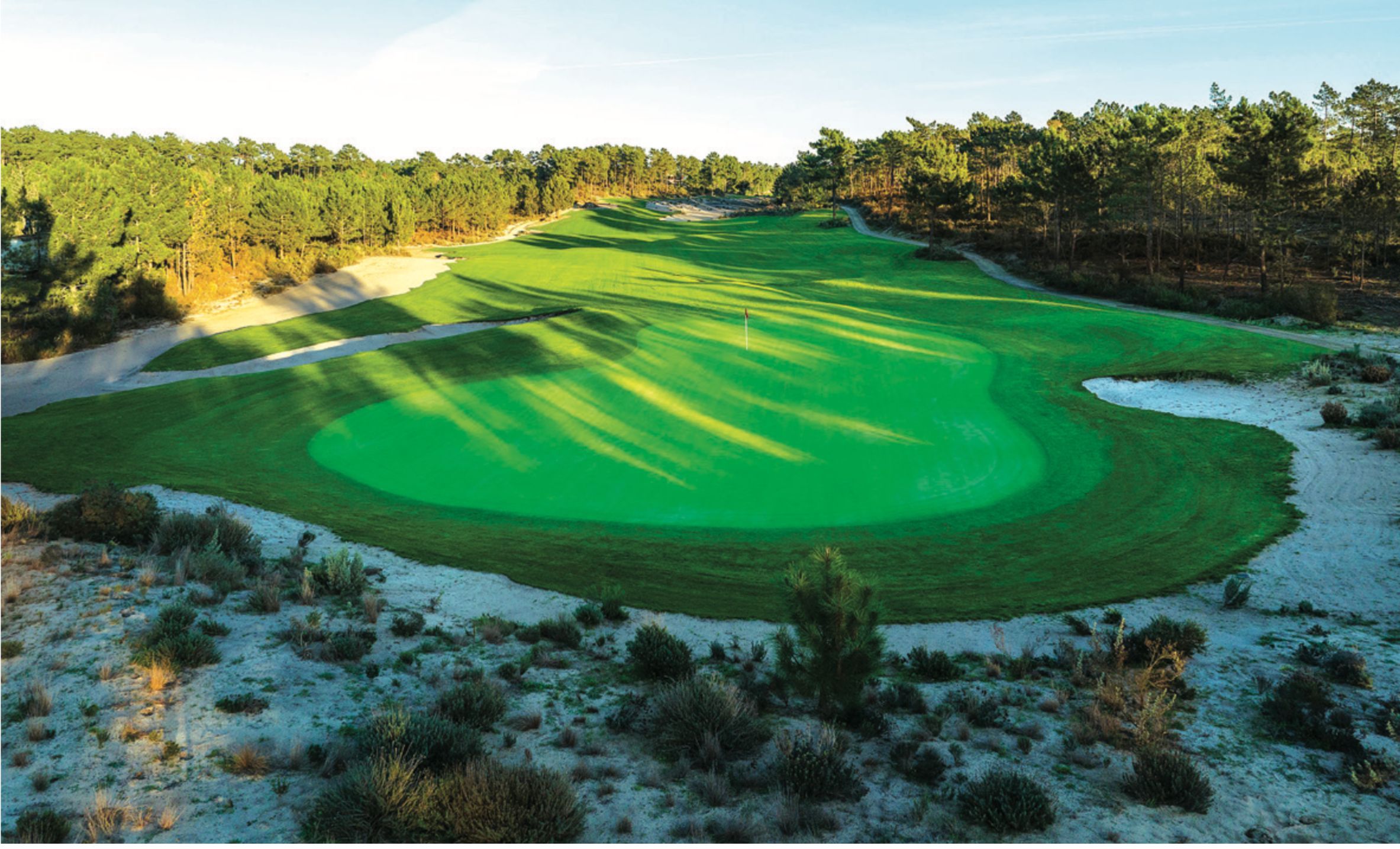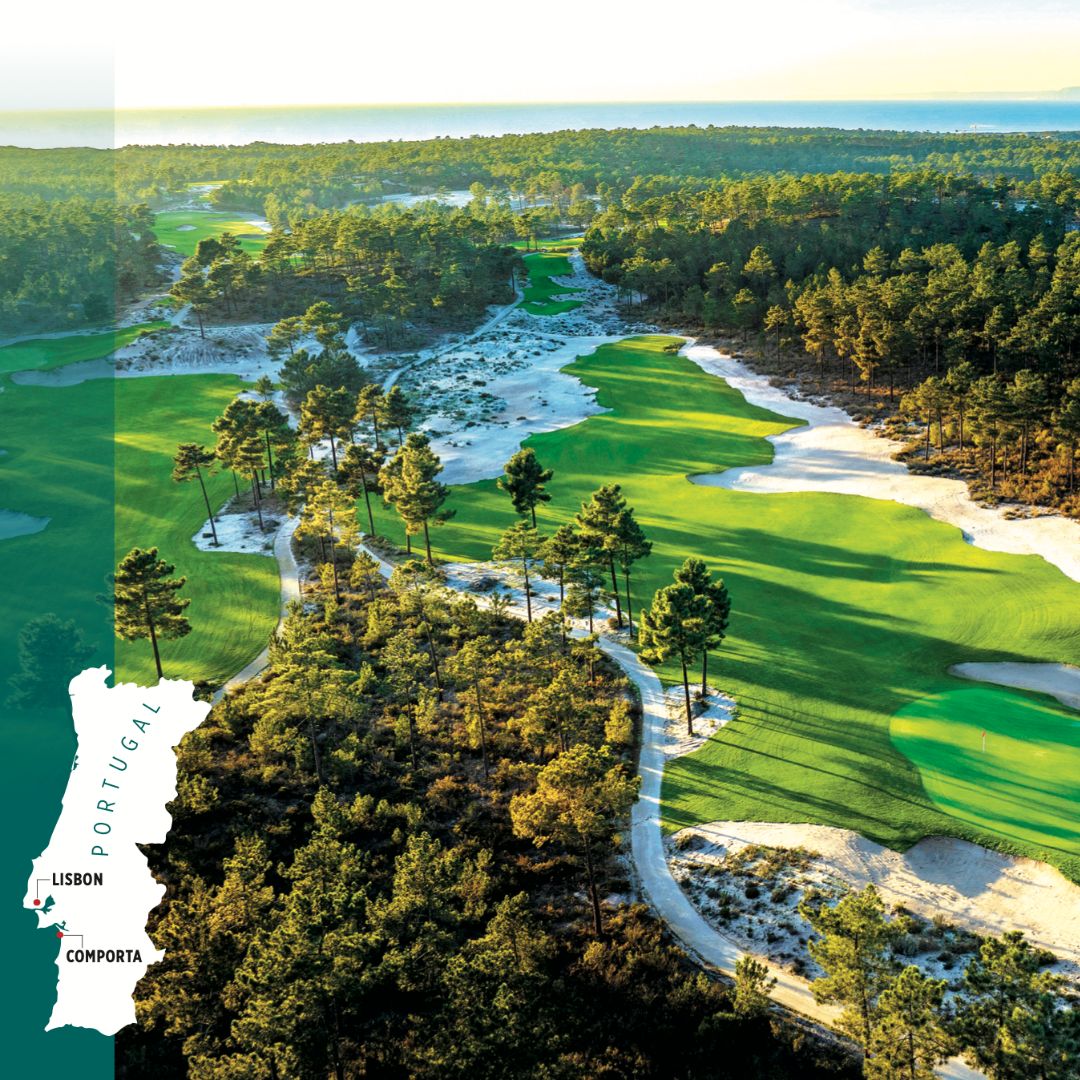
Europe’s New Superstar Playground
When architect David McLay Kidd played the first round on his brand-new Dunas course at Terras da Comporta, Chris Bertram was one of his playing partners...
“That’s what I want to hear, roars like that. That’s the excitement I think this course will create.”
David McLay Kidd is walking down the 14th of Terras da Comporta’s Dunas course, talking about the reactions in the group to his iron shot moments earlier narrowly failing to clear the front-left bunker of this exquisite par 3 and instead now sitting in the white sand of the front-left bunker.
It is the first time Kidd has played the full 18 holes of his brand-new design and he is having a thrilling match with his construction guru Conor Walsh, so his excitement is hardly a surprise. But he’s right. The Dunas course is an amusement arcade for golfers. Play it and walk off underwhelmed and unenthused and I’m not sure I will believe you.
I was the third member of the group, privileged to be part of the first tee time at a course I believe will establish itself in the top tier of continental golf the moment it fully opens.

The round was a long time coming; Kidd and I first talked about Dunas over dinner in the Ugadale Hotel in Machrihanish in 2012. We had met on the Mull of Kintyre to do a deep dive into his celebrated career for the now defunct Golf Illustrated and, after the interview was over, the conversation flowed as readily as the red wine.
Kidd is articulate and great copy, but I didn’t sense any embellishment on his part that night when he told me this course south of Lisbon he had started work on had the potential to be epic. More than a decade later, I saw for myself why he had been so giddy about it. In its scale, its variety of holes, its drama and its pure entertainment, Dunas has very, very few peers in continental Europe. And when I tell you I’m writing this a week on from that three-day visit and those seven days have been spent lecturing myself on not being too giddy about the inevitable excitement of a new course opening, it gives you an idea of how good I think it is.
It had a soft opening in May and will be fully open from October, and it is giving nothing away to say it will come in to the Continental Top 100 Courses ranking to be released in November. I’m happy to reveal now it will be top 50 – unless there are inexplicable final grow-in issues. Exactly where it enters the list will depend on my second visit later in the summer and the views of other panellists at that time.

But I’ve already got a number in my head where I think it might land, and it’s not No.49. It will make a significant splash, and that will be welcome reward for Kidd and all connected with a project that has been anything but straightforward.
Kidd, the Scotsman who conquered America when he designed the original course at the world’s No.1 golf resort Bandon Dunes, first became involved in it in 2008. He was to design Comporta Dunes while Tom Fazio was creating 36 holes called Comporta Links, which was going to be Portugal’s Ryder Cup bid.
They progressed nicely from 2010 but then the Portuguese banking institution Espirito Santo – who were behind this tourism complex on the Alentejo coast – ran into acute financial trouble in 2014. Kidd and his team were weeks away from finishing (the front nine was seeded, they were going to start the back nine the next morning), but overnight the game was up. When you’ve been in the business as long as he has, and been burnt before, you smell when things aren’t right. Kidd pulled all his team out by lunchtime.
REVIVING A GHOST TOWN

The course lay dormant for five years. Imagine that; this likely new superstar of European golf was perfectly shaped and even half-grassed, but was just eerily sitting there like a ghost town. Then, in November 2019, real estate developer Vanguard Properties bought it and contacted Kidd.
Nothing runs smoothly on Terras da Comporta project though, and along came the Covid pandemic to make life difficult for the Oregon-based architect and his team to restart the job. With travel and entry to Portugal difficult, Kidd suggested Walsh – his former staff shaper who worked on the project up to 2014 and now has his own construction company, CJW Golf – pick up the work. Their main task was to scalp the top layer of grass and reseed it with fescue. In the intervening five years, Kidd decided to make the greens fescue rather than bent-grass, which meant the greens were softened very slightly (given they expect to be slick and have a regular breeze), otherwise the course remains the same. The agronomy, grass to you and me, is one of the elements that makes Dunas different from almost everything else on the continent. The piles and piles of sand on the site and for miles around it, allied to Lisbon’s enviable climate, means fescue is possible.
So, even months before a soft opening in May and a full opening in October, and with the turf nowhere near where Terras da Comporta, Kidd or Walsh want it, you could play bump-and-run shots in a way unimaginable on all but a handful of courses on mainland Europe. There are no seaside holes in the manner of Troia, just along the peninsula, or indeed Oitavos Dunes, Praia D’El Rey or West Cliffs to the west and north of Portugal’s capital, but the fescue feast of Dunas plays more like a links than any of them.
“There’s no reason it shouldn’t play like a links. We’ve got a sea breeze, we’ve got sand, we’ve got fescue,” says Kidd excitedly, as we chat on the way back to the airport. “Once the fescue is grown in, it needs to be kept lean and dry. The GM, Rodrigo Ulrich, went to the US last summer on my recommendation and saw the links we built there. He went to Gamble Sands, he went to Sand Valley and he understood they’re public courses and the public are having a riot.

“They’re loving it because running the ball is so rare in the US and it’s so rare in southern Europe. Is it a stretch to say that Dunas will be unique in southern Europe in terms of being able to run the ball? This is such a rare opportunity here because of our proximity to the giant air conditioner called the Atlantic,” adds Kidd, who spent a morning marking out mowing patterns specifically to encourage golfers to use the ground game.
Dunas sits 1km from the ocean and, as you can see from the images, it has an individual ‘look’ to it, one I’m not sure exists anywhere else in Europe and is more akin to the likes of Sand Valley in Wisconsin. The back nine is much more advanced in agronomic terms so we played that more often, and it was so easy to be seduced by its elegance and aesthetic appeal. The front nine tumbles over more dramatic terrain and I’m not sure it isn’t even better.
The constant is holes routed along wide fairways lined by corridors of mature trees, where playability off the tee is paramount – with sandy waste areas populated with native vegetation – but with strategy on every tee shot. There is always a better side of the fairway to approach the green from, and often dramatic reward for a bold line.
There are sporty par 4s where pretty much all golfers will have the length to get at least close to the green, but there is also a clear route for those who want to plot cautiously. There are tee shots, whether from elevated tees or where there is excitement in clearing a bunker on the Tiger line, where you will simply be desperate to get your tee in the ground and have a go.
On our final evening we were racing a little against darkness at the end, but the pace of play was noticeably rapid. The strategy was obvious as you walked onto the tee and there was an urgency from all of us to hit the shot we’d seen. Kidd makes you feel aggressive, not defensive. Confident, not intimidated. Giddy, not tense. And he wants it to be strategic
for everyone, not just stronger players who can place their ball in certain spots. Everyone gets a chance to feel the thrill of pondering their tactics and then have an opportunity to execute it.
The par 3s are rarely less than outstanding, whether the 6th, cut between two dunes, the strong 3rd or the breathtakingly-framed 17th.
Dunas has buggy paths, which are a necessary evil for a tourist course, but you can’t help but lament them, for this is a walkable routing (in fact, done by Donald Steel before he retired). Residences will surely pop up at numerous places, but for now it is dripping in tranquility and purity. You look back down a hole – and the 7th springs to mind, with hints of Augusta’s 2nd – and see the red flag fluttering against this pure backdrop of fescue, white sand and pines, and you can’t help but think this is a special place to play the game.
It stops you in your tracks to digest and appreciate the scene in a way common to beachside or clifftop courses, but much less common away from the coast other than on dreamy heathlands. Kidd happily acknowledges he was given an epic site and the big thing he had to show was restraint.
He has got it just right, and the Dunas course will have roars echoing between its pines every hour of every day it is open.
More posts

APPAREL AS PERFORMANCE GEAR
25 Jun 2025
UNIVERSO FERRARI DEBUTS IN THAILAND
22 Jun 2025

